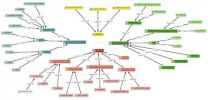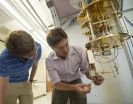(Press-News.org) DNA mutations—long known to fuel cancer as well as evolutionary changes in a living organism—had been thought to be rare events that occur randomly throughout the genome.
However, recent studies have shown that cancer development frequently involves the formation of multiple mutations that arise simultaneously and in close proximity to each other. These groups of clustered mutations are frequently found in regions where chromosomal rearrangements take place.
The discovery, published in the journal Cell Reports, may one day lead to new cancer therapies, according to a University of Iowa biologist and her colleagues, and a group of researchers from the National Institute of Environmental Health Sciences led by Senior Associate Scientist Dmitry Gordenin.
The formation of clustered mutations may result from the process of DNA repair.
Anna Malkova, associate professor of biology in the UI College of Liberal Arts and Sciences, notes that the DNA repair pathway, known as break-induced replication (BIR), can promote clusters of DNA mutations.
"Previously, we have shown that double-strand DNA breaks, which can result from oxidation, ionizing radiation and replication errors, can be repaired by BIR," says Malkova.
"During BIR, one broken DNA end is paired with an identical DNA sequence on another chromosome and initiates an unusual type of replication, which proceeds as a migrating bubble and is associated with the accumulation of large amounts of single-strand DNA," she says.
In the Cell Reports study, researchers subjected yeast cells undergoing BIR to alkylating (cancer cell-killing agents) damage. "We found that the single-stranded DNA regions that accumulate during BIR are susceptible to damage that leads to the formation of mutation clusters," explains Cynthia Sakofsky, postdoctoral fellow at the UI and one of two co-first authors on the paper. "These clusters are similar to those found in human cancer," she says.
Importantly, say the researchers, the paper provides a mechanism to potentially explain how genetic changes form in human cancers. Thus, it will be critical for future research to determine whether BIR can form clustered mutations that lead to cancer in humans. If this turns out to be true, it may lead to the discovery of new targets for developing therapies against human cancers.
INFORMATION:
In addition to Malkova, Gordenin and Sakofsky, co-authors of the paper are: Steven A. Roberts, co-first author, and Michael A. Resnick, both of the National Institute of Environmental Health Sciences, Research Triangle Park, North Carolina; and Ewa Malc and Piotr A. Mieczkowski, both of the Department of Genetics, Lineberger Comprehensive Cancer Center and Carolina Center for Genome Sciences, University of North Carolina, Chapel Hill, North Carolina.
The paper, titled "Break-Induced Replication Is a Source of Mutation Clusters Underlying Kataegis," was published in the May 29 issue of Cell Reports.
The research was funded by NIH grants R01GM084242 (to A.M.) and 5R01GM052319-17 (to P.A.M.) and by the Intramural Research Program of the NIH, National Institute of Environmental Health Sciences (project ES065073, to M.A.R). S.A.R. was supported by NIH Pathway to Independence Award K99ES022633-01.
Biologists describe mechanism promoting multiple DNA mutations
Research could lead to development of new cancer therapies
2014-07-30
ELSE PRESS RELEASES FROM THIS DATE:
Classic Lewis Carroll character inspires new ecological model
2014-07-30
Inspired by the Red Queen in Lewis Carroll's Through the Looking Glass, collaborators from the University of Illinois and National University of Singapore improved a 35-year-old ecology model to better understand how species evolve over decades to millions of years.
The new model, called a mean field model for competition, incorporates the "Red Queen Effect," an evolutionary hypothesis introduced by Lee Van Valen in the 1970s, which suggests that organisms must constantly increase their fitness (or ability to survive and reproduce) in order to compete with other ever-evolving ...
Diverticulitis patients reveal psychological, physical symptoms long after acute attacks
2014-07-30
UCLA researchers interviewed people with diverticulitis and confirmed that many suffer psychological and physical symptoms long after their acute illness has passed.
For the study, published this week in the peer-reviewed journal Quality of Life Research, a UCLA team led by Dr. Brennan Spiegel interviewed patients in great detail about the symptoms they experience weeks, months or even years after an acute diverticulitis attack. Their striking findings add to growing evidence that, for some patients, diverticulitis goes beyond isolated attacks and can lead to a chronic ...
Finding quantum lines of desire
2014-07-30
Groundskeepers and landscapers hate them, but there is no fighting them. Called desire paths, social trails or goat tracks, they are the unofficial shortcuts people create between two locations when the purpose-built path doesn't take them where they want to go.
There's a similar concept in classical physics called the "path of least action." If you throw a softball to a friend, the ball traces a parabola through space. It doesn't follow a serpentine path or loop the loop because those paths have higher "actions" than the true path.
But what paths do quantum particles, ...
Tidal forces gave moon its shape, according to new analysis
2014-07-30
The shape of the moon deviates from a simple sphere in ways that scientists have struggled to explain. A new study by researchers at UC Santa Cruz shows that most of the moon's overall shape can be explained by taking into account tidal effects acting early in the moon's history.
The results, published July 30 in Nature, provide insights into the moon's early history, its orbital evolution, and its current orientation in the sky, according to lead author Ian Garrick-Bethell, assistant professor of Earth and planetary sciences at UC Santa Cruz.
As the moon cooled and ...
Target growth-driving cells within tumors, not fastest-proliferating cells
2014-07-30
BOSTON –– Of the many sub-groups of cells jockeying for supremacy within a cancerous tumor, the most dangerous may not be those that can proliferate the fastest, researchers at Dana-Farber Cancer Institute report in a paper appearing in an advance online publication of the journal Nature. The findings have important implications for the treatment of cancer with precision medicines, the study authors explained: Doctors need to ascertain which cell subgroups are truly driving the tumor's growth and metastasis and select drugs that target the critical genes within those cells. ...
ALMA finds double star with weird and wild planet-forming discs
2014-07-30
BOWLING GREEN, O.—From movies to television, obesity is still considered "fair game" for jokes and ridicule. A new study from researchers at Bowling Green State University took a closer look at weight-related humor to see if anti-fat attitudes played into a person's appreciation or distaste for fat humor in the media.
"Weight-Related Humor in the Media: Appreciation, Distaste and Anti-Fat Attitudes," by psychology Ph.D. candidate Jacob Burmeister and Dr. Robert Carels, professor of psychology, is featured in the June issue of Psychology of Popular Media Culture.
Carels ...
Innovative scientists update old-school pipetting with new-age technology
2014-07-30
CAMBRIDGE, Mass. (July 30, 2014) A team of Whitehead Institute researchers is bringing new levels of efficiency and accuracy to one of the most essential albeit tedious tasks of bench science: pipetting. And, in an effort to aid the scientific community at large, the group has established an open source system that enables anyone to benefit from this development free of charge.
Dubbed "iPipet," the system converts an iPad or any tablet computer into a "smart bench" that guides the execution of complex pipetting protocols. iPipet users can also share their pipetting designs ...
Mapping the optimal route between 2 quantum states
2014-07-30
As a quantum state collapses from a quantum superposition to a classical state or a different superposition, it will follow a path known as a quantum trajectory. For each start and end state there is an optimal or "most likely" path, but it is not as easy to predict the path or track it experimentally as a straight-line between two points would be in our everyday, classical world.
In a new paper featured this week on the cover of Nature, scientists from the University of Rochester, University of California at Berkeley and Washington University in St. Louis have shown ...
Young binary star system may form planets with weird and wild orbits
2014-07-30
Unlike our solitary Sun, most stars form in binary pairs -- two stars that orbit a common center of mass. Though remarkably plentiful, binaries pose a number of questions, including how and where planets form in such complex environments.
While surveying a series of binary stars with the Atacama Large Millimeter/submillimeter Array (ALMA), astronomers uncovered a striking pair of wildly misaligned planet-forming disks in the young binary star system HK Tau. These results provide the clearest picture ever of protoplanetary disks around a double star and could reveal important ...
Scientists reproduce evolutionary changes by manipulating embryonic development of mice
2014-07-30
A group of researchers from the University of Helsinki and the Universitat Autònoma de Barcelona have been able experimentally to reproduce in mice morphological changes which have taken millions of years to occur. Through small and gradual modifications in the embryonic development of mice teeth, induced in the laboratory, scientists have obtained teeth which morphologically are very similar to those observed in the fossil registry of rodent species which separated from mice millions of years ago.
To modify the development of their teeth, the team from the Institute ...
LAST 30 PRESS RELEASES:
The Ceramic Society of Japan’s Oxoate Ceramics Research Association launches new international book project
Heart-brain connection: international study reveals the role of the vagus nerve in keeping the heart young
Researchers identify Rb1 as a predictive biomarker for a new therapeutic strategy in some breast cancers
Survey reveals ethical gaps slowing AI adoption in pediatric surgery
Stimulant ADHD medications work differently than thought
AI overestimates how smart people are, according to HSE economists
HSE researchers create genome-wide map of quadruplexes
Scientists boost cell "powerhouses" to burn more calories
Automatic label checking: The missing step in making reliable medical AI
Low daily alcohol intake linked to 50% heightened mouth cancer risk in India
American Meteorological Society announces Rick Spinrad as 2026 President-Elect
Biomass-based carbon capture spotlighted in newly released global climate webinar recording
Illuminating invisible nano pollutants: advanced bioimaging tracks the full journey of emerging nanoscale contaminants in living systems
How does age affect recovery from spinal cord injury?
Novel AI tool offers prognosis for patients with head and neck cancer
Fathers’ microplastic exposure tied to their children’s metabolic problems
Research validates laboratory model for studying high-grade serous ovarian cancer
SIR 2026 delivers transformative breakthroughs in minimally invasive medicine to improve patient care
Stem Cell Reports most downloaded papers of 2025 highlight the breadth and impact of stem cell research
Oxford-led study estimates NHS spends around 3% of its primary and secondary care budget on the health impacts of heat and cold in England
A researcher’s long quest leads to a smart composite breakthrough
Urban wild bees act as “microbial sensors” of city health.
New study finds where you live affects recovery after a hip fracture
Forecasting the impact of fully automated vehicle adoption on US road traffic injuries
Alcohol-related hospitalizations from 2016 to 2022
Semaglutide and hospitalizations in patients with obesity and established cardiovascular disease
Researchers ‘listen in’ to embryo-mother interactions during implantation using a culture system replicating the womb lining
How changing your diet could help save the world
How to make AI truly scalable and reliable for real-time traffic assignment?
Beyond fragmented markets: A new framework for efficient and stable ride-pooling
[Press-News.org] Biologists describe mechanism promoting multiple DNA mutationsResearch could lead to development of new cancer therapies







